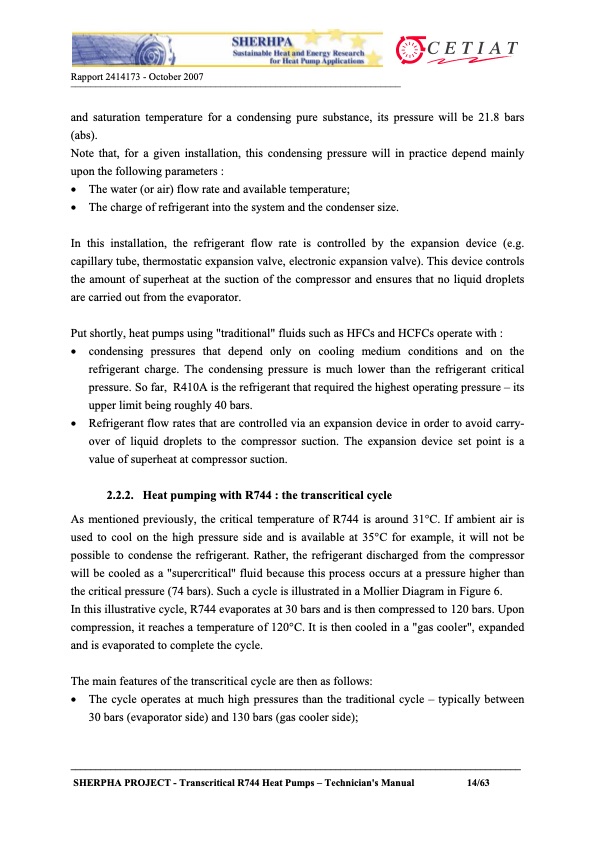
PDF Publication Title:
Text from PDF Page: 015
Rapport 2414173 - October 2007 __________________________________________________________________ and saturation temperature for a condensing pure substance, its pressure will be 21.8 bars (abs). Note that, for a given installation, this condensing pressure will in practice depend mainly upon the following parameters : • The water (or air) flow rate and available temperature; • The charge of refrigerant into the system and the condenser size. In this installation, the refrigerant flow rate is controlled by the expansion device (e.g. capillary tube, thermostatic expansion valve, electronic expansion valve). This device controls the amount of superheat at the suction of the compressor and ensures that no liquid droplets are carried out from the evaporator. Put shortly, heat pumps using "traditional" fluids such as HFCs and HCFCs operate with : • condensing pressures that depend only on cooling medium conditions and on the refrigerant charge. The condensing pressure is much lower than the refrigerant critical pressure. So far, R410A is the refrigerant that required the highest operating pressure – its upper limit being roughly 40 bars. • Refrigerant flow rates that are controlled via an expansion device in order to avoid carry- over of liquid droplets to the compressor suction. The expansion device set point is a value of superheat at compressor suction. 2.2.2. Heat pumping with R744 : the transcritical cycle As mentioned previously, the critical temperature of R744 is around 31°C. If ambient air is used to cool on the high pressure side and is available at 35°C for example, it will not be possible to condense the refrigerant. Rather, the refrigerant discharged from the compressor will be cooled as a "supercritical" fluid because this process occurs at a pressure higher than the critical pressure (74 bars). Such a cycle is illustrated in a Mollier Diagram in Figure 6. In this illustrative cycle, R744 evaporates at 30 bars and is then compressed to 120 bars. Upon compression, it reaches a temperature of 120°C. It is then cooled in a "gas cooler", expanded and is evaporated to complete the cycle. The main features of the transcritical cycle are then as follows: • The cycle operates at much high pressures than the traditional cycle – typically between 30 bars (evaporator side) and 130 bars (gas cooler side); __________________________________________________________________________________________ SHERPHA PROJECT - Transcritical R744 Heat Pumps – Technician's Manual 14/63PDF Image | Transcritical R744 (CO2) Heat Pumps 2017

PDF Search Title:
Transcritical R744 (CO2) Heat Pumps 2017Original File Name Searched:
Manuel-CO2.pdfDIY PDF Search: Google It | Yahoo | Bing
CO2 Organic Rankine Cycle Experimenter Platform The supercritical CO2 phase change system is both a heat pump and organic rankine cycle which can be used for those purposes and as a supercritical extractor for advanced subcritical and supercritical extraction technology. Uses include producing nanoparticles, precious metal CO2 extraction, lithium battery recycling, and other applications... More Info
Heat Pumps CO2 ORC Heat Pump System Platform More Info
| CONTACT TEL: 608-238-6001 Email: greg@infinityturbine.com | RSS | AMP |